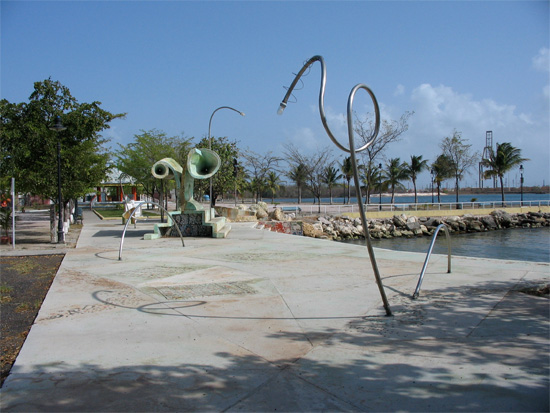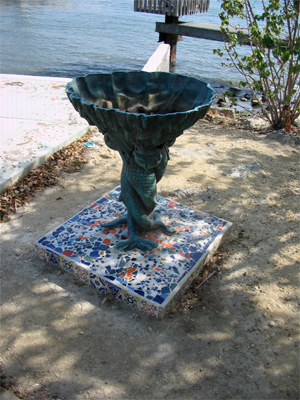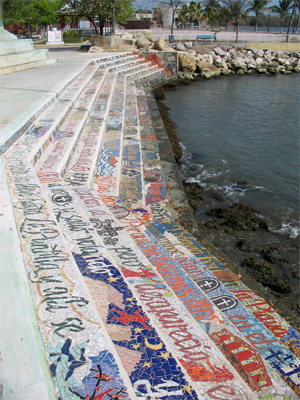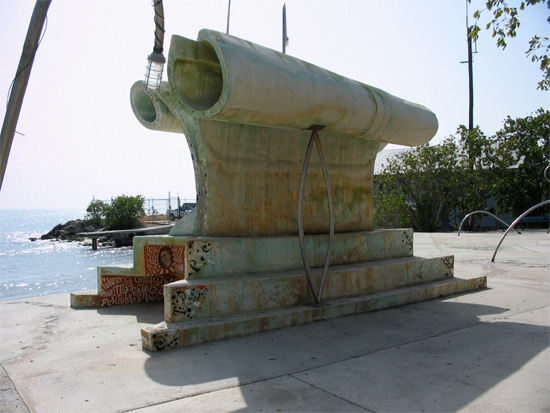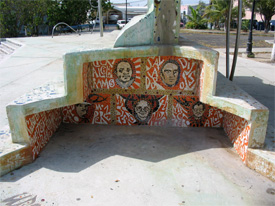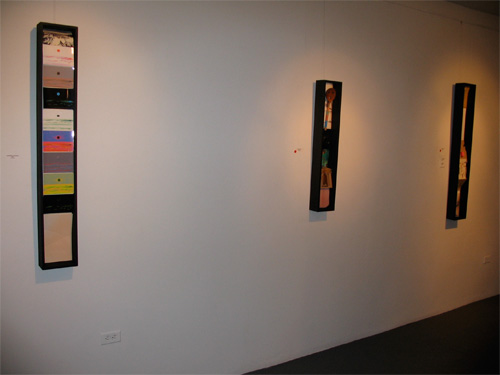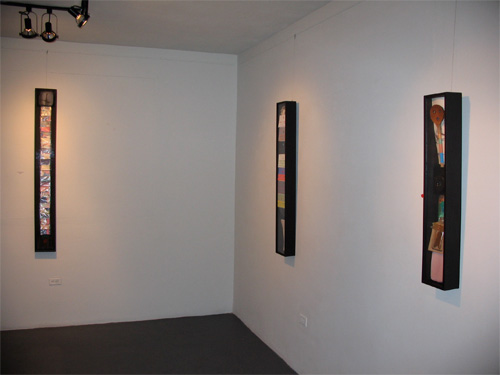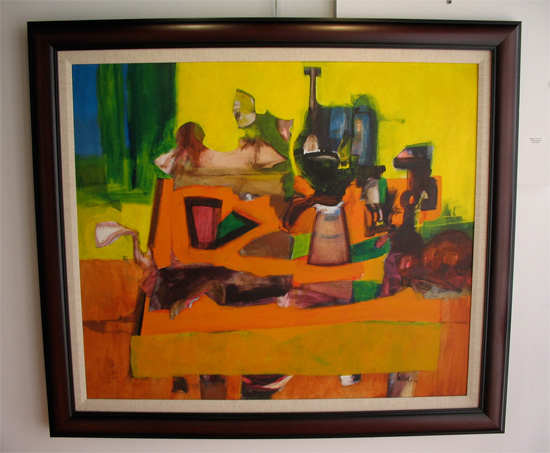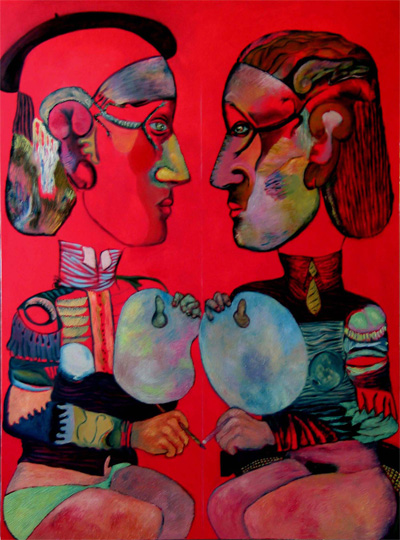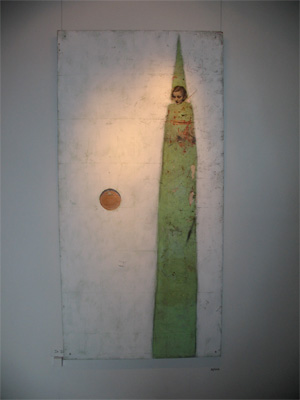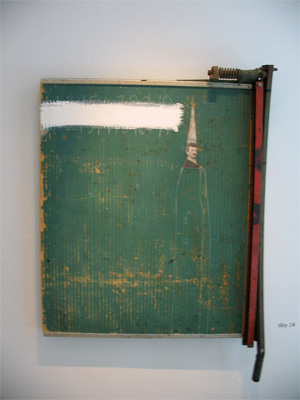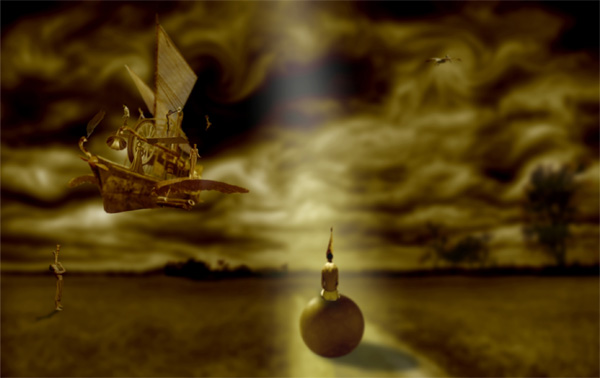|
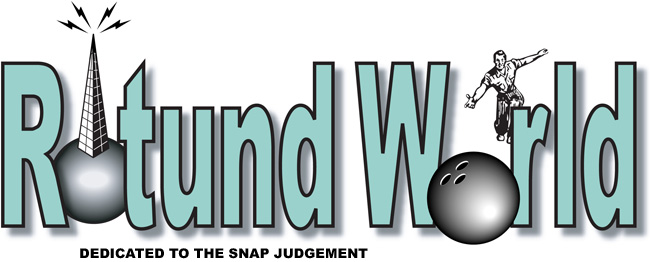
Who Put the Bomp?
You wouldn’t think that Antonio Martorell could make something ungainly or ugly. Overdone, perhaps, rococo certainly. Witness the orgasmic florescence of his rooms at Hotel El Convento in Viejo San Juan, every surface dabbled on, every square centimeter ripely tarted up with some Martorellian wand-wave: the fixtures, the doors, the passageways, even the flowerpots on the balconies. You may find his paintings gauzy trifles compared to those biting, ferocious, irrefutable prints he was doing in the 1970s and 80s, those acid commentaries on the island’s lapdog subservience to the interests of rapacious Continental cowboys. How we need such ferocity right now. You might think the artist’s best days are behind him, although an enduring, affecting presence like him, a towering figure on the artistic landscape, insistently nosing around in Puerto Rico’s cultural weed patch and vociferating about it in that chewy, self- loving but likewise unstoppable mock-poetic burble of his at every opportunity. He is a national treasure and ought to be accorded unconditional respect and some gratitude, because people like him, diligent laborers disguised as eccentric, celebrity-grubbing pets of the upper classes don’t come along every generation. Can you say the same? Still, one shouldn’t let pass every faux pas just because someone is a vital cog and basically a nice guy. Especially when it comes to public art, which we all must live with, more or less forever.
The last time we were in Ponce, a friend of ours—we are not without friends!—drayed us to a park in the old bayside neighborhood called La Playa, to show us something off the beaten path. We love an adventure, especially in that forlorn pueblo which seems to us largely without redeeming qualities. There, at El Parque de la Playa, lies a public artwork created —perhaps impelled—by El Maestro, an installation that’s relatively small-scale and yet manages to sprawl all over the place. It’s not bad. It has everything: listing and curlicued lampposts, a concrete lovers’ bench posing as a frigate, incomprehensible and no doubt poetic scatterings of letters and words inlaid in the sidewalks. There is a hideously kitsch, sea-creature fountain, a real nose-thumber if you know Martorell like we do. The loveliest part of this cosmos-and-sea-themed installation is a mosaic stairway leading right into the water—once a year the starting point for a mass swim out to Isla Cardona, a mile or so away—with pictograph-studded phrases that spell out local legends and histories: the shipwreck in the bay, the handsome devil who visited a local bar, and so forth.
In the midst of all this twinkle-toed frippery, however, sits a butt-ugly, scroll-headed wall of concrete, trying to look like breaking waves we suppose. (Remember, the rule is “butt-ugly” and “buck-naked,” never the other way around.) It’s as painful to look at as a newly minted carbuncle. Imagine a charming little fairyland, with sparkling fairy streams and twisting fairy streets lined with fairy split-levels, in the midst of which someone has tossed Mother Hubbard’s well-worn combat boot, perhaps from a passing car. This clodhopper is so dizzily ill-proportioned that it required additional buttressing to keep it from cracking apart and toppling on unwary landlubbers seated in its shadows. Too bad, because contained within hollows at either end of this monumental mistake are winning mosaic portraits of some of the island’s most memorable poets, artists, musicians, politicians; Ponceños all. Martorell at his character-sketching best Speaking of Martorell’s salad days, there is presently a snazzy, small exhibition of prints with social themes at Museo de Arte de Ponce, in which a 1973 Martorell woodcut appears. Many of the works make reference to the end of slavery in Puerto Rico, as does Martorell’s, an image of a photo album with a missing picture, titled ¿Y tu abuela, dónde está? It’s a typically simple, fleet-minded act on the artist’s part, turning on its head an old island adage about racial purity and transforming it into scorching commentary. About now our fed-up readership is probably holding its collective nose and making barfing noises, and saying to itself, “Why are those fools wasting our time with such pinches pendejadas when there is so much real stuff going on? Who gives a flying mangó carcomido about something as derriere-garde and off-the-beaten path as a public artwork in Ponce, Puerto Rico?” And indeed, we’re having a low-grade Rotund nervous breakdown trying to sort out all of the things we want to tell you about but can’t find the time—or, it seems, the capacity—to speak of in an orderly fashion. As anyone with the stomach to actually peruse these pages knows, we believe that art has reached new, unspeakable levels of commodification and meaninglessness. As with “fine” wines, “custom-made” chocolates, and cellular phones, branding is everything, and today’s brand in art is “young, emerging, and acting out.” So it is with a tiny measure of satisfaction that the Rotund spyglass reports some shows that opened recently on the island—but not so recently that they haven’t already closed—which contain large numbers of old-fashioned oil-on-canvas-or-whatever paintings. Ho-ho. Come with us now to the classics stacks, way, way in the back, and we’ll work our way forward. The gallery at La Universidad del Sagrado Corazon is showing a handsome handful of paintings and sculptures by the late Eduardo Vera Cortés, whom you might know as a poster-maker and recent honoree of La Muestra Nacional. Indeed, his graphic works figure among the strongest of the mid-twentieth-century artist-social activists, but he was no slouch as a painter and sculptor. Like the Mexican artists whose work his resembles—David Alfaro Siqueiros comes to mind—Vera Cortés’s paintings have their share of industrious worker tableaux—or peasant tableaux, in this case—and more than a few dogs. There are also still lifes and street scenes. The light is often diffuse, but there are occasional intensities of color and volumetric depths which make even mundane scenes like a gathering of street dogs or an after-dinner table as rich as any verdant, sun-soaked landscape. The gallery is open scholar’s hours, by which we mean Monday through Thursday from 9 to noon and 1 to 5, and Saturday 10 to 3. You can email José Fonseca at with any questions. As we told you last time, the cheeky, very bohemian Julio Micheli had a show of artbox-treasure chests at La Casa del Arte in San Juan earlier this month—it’s still up if you’re very, very lucky—and we have, as promised, a couple of installation shots below.
Micheli was also honored by Ponce’s Galería Trinitaria with one of what they’re billing as “Noches de coleccionistas,” providing the public with a relatively rare glimpse at the artist’s slathery semi-abstract paintings from the 1960s and 70s. Below is Bodegón con vaso (1972, acrylic on masonite, 36" x 42"). Gallery director Félix Rivera also put up some of Micheli’s distinctly erotic watercolors of more recent vintage, and nalgasosas they are. If you’re a sniffy sanjuanero, it might pay to call the gallery before burning all that fossil fuel to get to Ponce: 787-259-1034, extención 235. You can also visit the website. On the other hand, a trip to La Perla del sur is an opportunity for all kinds of cultural, caffeinated, and gastronomic whoopdedoo: a visit to Museo de Arte de Ponce, Museo de la Historia de Ponce, Casa de la Masacre, King’s Creme, Café Mayor . . . an amazingly tiptop agenda for a place many people can’t wait to get out of.
The Joy DivisionAmong Ponceños who fled the city as soon as their little legs could carry them was Elizam Escobar. Escobar has since had a full life, including a lengthy stint in the pokey in the U.S. for his political activities on behalf of Puerto Rican independence. According to his jailhouse writings, Escobar spent a lot of time thinking about art and using the meager resources he got his hands on to make it. From what we’ve seen of his present-day production, the effects of so much meditation and enforced improvisation are far more salutary than being sentenced to art school. The works in his chock-full, wide-ranging exhibition at Galería Petrus this month, Cámara Obscura/Enmatrizamientos/ConSecuencias, show a very squared-away painter who loves a good story. The themes that Escobar works over—or, better said, saunters attentively up to—are nothing new: the complicated feelings between men and women, the masks we wear when facing each other, the artist’s conundrums before the canvas and the writer’s in front of the screen, the lives of cats. The artist also pays special attention to pregnancy, perhaps signaling a blessed event in his own life. Who knows?
But shining through all the rather standard-grade psycho-postulating is Escobar’s commitment to moving pigment around on canvas, his love of color, and his wry and settled viewpoint. A few of the paintings just wowed us for reasons we cannot easily explain: the very, very red Pintoras (2006, oil on canvas, 48" x 36"), above, in which even the penis-shaped ears of the communing figures did not diminish our interest one whit, and El escritor, a scene of fey distraction, showing the writer and the woman in his den who inspires him or bores him; he seems intent on some other, perhaps more amusing inner world. This painting reminded us of the work of a an early-twentieth-century artist we saw at Museo de Arte Moderno in el De Efe, the tragic Abraham Ángel, a romantically inclined portraitist and scene painter whose fantastic coloration made the whole world look alive and deeply sensual. Ángel died at the age of nineteen. It’s almost impossible to believe, but Escobar told us that Galería Petrus would keep his show on the walls only until mid-March, which may have passed by the time you read this. Call the gallery at 787-289-0505 to find out, and use a slightly reproving tone if it’s true. Or you can email them, but the effect won’t be the same. In any event, you’ll have to talk to someone to find out the gallery’s hours. Petrus is located at Calle Hoare #726, where Hoare crosses Calle Las Palmas. The image above comes to us courtesy of the artist, though it may have been taken by Johnny Betancourt. Viota Gallery also has a show largely comprised of paintings, Casa del ser, recent works by Luis García-Nerey. But García-Nerey seems less interested in the act of applying color to canvas—or, in his case, found pieces of masonite or safety deposit boxes—than in creating an idea about what it’s like to suffer human consciousness. The painting looks, to our admittedly near-sighted peepers, not exactly perfunctory but just energetic enough to provide an atmosphere for the cone-hatted, obelisk-bodied figures, whose tiny heads appear to be cutout copy machine renditions of old photos or magazine prints. Is that Gertrude Stein teetering atop the scabby white column? Could that one be Thomas Hardy? Betty Davis? We rather doubt it, but anything’s possible. Rather than literary, philosophical, or pop-culture references, the point seems to be that existence consists of solitary voids, perhaps in sight of other lonely souls floating in the liquid-like expanse of shapeless destinies. We rather like the conceit, and kind of agree with it. Once again, we had our favorites: the lovely, moonstruck Sylvia (2006, mixed media on masonite, 86" x 43"), below left, whose green raiment and quizzical amusement rang the bell perfectly for us. Anyone mounted on a big paper cutter gets lots of points from the Rotund accounting department, so Day 14 (2006, mixed media on masonite, 46" x 33"), below right, makes our list in spite of looking something like a graduation ceremony. We were totally impressed with how tall Sunday Morning is and hope to date someone that size one day, Inquisition hat or not.
According to an artist friend of ours, García-Nerey has a future, even though we were convinced, before we had that conversation, that he is well into it. He certainly has the confidence, and we’ll be looking in on him with great interest. You can begin your own artist watch by visiting Viota at 793 Avenida San Patricio. Call 787-782-1752 to find out gallery hours and the duration of the show, or—ta-da!—visit the website. We hate to scrimp on any discussion of new exhibitions, but it’s getting late, we’re worn to a frazzle, and you probably have to get going. Tallboys await, no doubt. So many dance floors, so little time. And so forth. We’ll leave you to your indulgences with a single, bright word: Photoshop. Time was when every digitally altered photograph had that signature Photoshop look: garish web-safe colors; limited, insipid, instantly recognizable filter effects; bad seams. At some point in the 1990s artists began to catch on and occasionally you’d see decent, believable compositions. Not so original, but what a relief. Perhaps Jean-Michel Fiedler represents the wave of the future, and while we’re not sure if his exhibition Éxodos at Galería 356 is a great leap forward or a bellyflop in gaseous self-referentiality, we’re willing to err on the side of friendly curiosity. The muzzy wet dream which Fiedler shows us, a cloud-riven, sepia-toned realm where winged, horn-equipped ships ply both air and stream, seems to be populated largely by willowy, sheet-wearing boys. Some have borrowed cone hats from García-Nerey. Without getting into how Fiedler might have created these tableaux—and it’s to his credit that we really didn’t much care, so convincing are his fantastic scenarios—we’ll just say that what you see certainly doesn’t look like Kansas. It could be the land of Guilty Pleasure: Éxodo 20 (2006, digitografía—whatever that may be—31" x 19"), below, shows a solitary figure sitting cabizbajo in a shaft of light on a large ball, cone hat on head. The source of the light is the work’s best mystery since the skies are roiling with massive dark clouds. A winged airship is passing above, although the boy seems not to notice the vessel or its crew of other, similarly pale, thin, and almost naked fellows. Something like a pterodactyl flits through the clouds in the far distance.
Aside from their kinship with standard dreams of flying and dream-like children’s stories—In the Night Kitchen comes most obviously to mind—we have only one open complaint about these works: they suffer a kind of sameness once you get over the ingenuity of this or that flying machine. You can look at this unkindly and say that Fielder doesn’t yet have a grip. Or you can be generous of spirit, as we at Rotund World ever strive to do. We’re convinced that the images of Éxodos represent that nebulous hunger, desire, more than specific narratives. Desire, the shapeless intensity we know so well; but how to describe it to others? We can never hope to convey it exactly—nor would we want to—but Fiedler’s Éxodos make a fair stab. He certainly knows his technical stuff, and we think it’s now a matter of finding the right indirection. Gallery director Michele Fiedler—surprise! an actual relative of the artist—is doing a smashing job with the programming at Galería 356, and we encourage you to make Éxodos your first visit if you haven’t been there before. As we’ve mentioned on several occasions, the gallery is located at César González 356 in San Juan, and you should call 787-282-7820 to confirm the hours and get directions. If you’re driving, good luck. Like all modern enterprises with brains, Galería 356 has email and a website. Thanks to Michele for the image. Is That All There Is?In the previous Rotund episode—publishing types never say “last,” which is thought to bring back luck—we hardly gave a damn. We laughed, we cried, we got up and went home. You might think, “That's nothing. I do that all the time,” but friends, this is the Rotund way we’re talking about. To see what this might mean for you, your family, your friends, and your community, click on the link below. We’ll tell you this: it’s all about an enchanted little island in a deep blue sea, some crazy artists, and their strange habits . . . Black eye? Or feather in our cap? Look here. |




